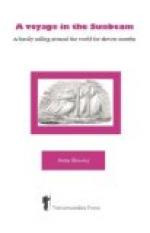We now moved our position a little higher up the river, to the Falls, over which the men, gliding down the shallow rapids above, in a sitting posture, allowed themselves to be carried. It looked a pleasant and easy feat, and was afterwards performed by many of the natives in all sorts of ways. Two or three of them would hold each other’s shoulders, forming a child’s train, or some would get on the backs of their companions, while others descended singly in a variety of attitudes. At last a young girl was also persuaded to attempt the feat. She looked very pretty as she started, in her white chemise and bright garland, and prettier still when she emerged from the white foam beneath the fall, and swam along far below the surface of the clear water, with her long black hair streaming out behind her.
No description can give you any idea what an animated and extraordinary scene it was altogether. While our accounts were being settled, preparatory to our departure, I occupied myself in looking at some kahilis and feather leis. The yellow ones, either of Oo or Mamo feathers, only found in this island, are always scarce, as the use of them is a prerogative of royalty and nobility. Just now it is almost impossible to obtain one, all the feathers being ‘tabu,’ to make a royal cloak for Ruth, half-sister of Kamehameha V., and governess of Hawaii. Mamo feathers are generally worth a dollar a piece, and a good lei or loose necklace costs about five hundred dollars. Kahilis are also an emblem of rank, though many people use them as ornaments in their houses. They are rather like feather-brooms, two or three feet long, and three or four inches across, made of all sorts of feathers, tastefully interwoven. I bought one, and a couple of ordinary leis, which were all I could procure. But, alas! too soon all was over, and time for us to go on board.
[Illustration: Feather Necklace]
On our way off to the yacht we met one of the large double canoes coming in under sail from a neighbouring island. It consisted of two canoes lashed together, with a sort of basket dropped into the water between them, to enable them to carry their fish alive. They are not very common now, and we were therefore fortunate in meeting with one. Mr. Lyman made the men in charge turn her round, so as to afford us an opportunity of thoroughly examining her. In the time of Kamehameha there was a fleet of 10,000 of these canoes, and the king used to send them out in the roughest weather, and make them perform all sorts of manoeuvres.
We found the yacht in the usual state of confusion incidental to a fresh departure, but everything was soon reduced to order, and off we started to steam and sail round the north end of the island, but we could not afford time to visit the place of Captain Cook’s death and burial in Keelakeakua Bay. I believe there is not a great deal to see, however, and the spot is chiefly interesting from its associations.




